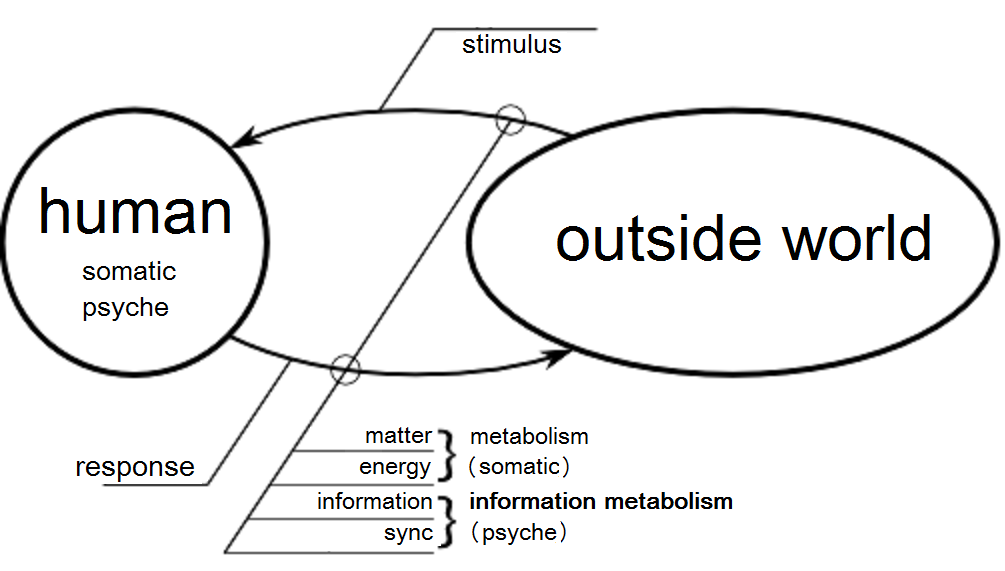Structure of the information flow resulting from interactions of the psyche with the world.
The "man - extermal world" system presents, perhaps, the most important system which interests as single individuals so the humanity as a whole. Our entire lives are constant interactions with the world: with other people, groups, state structures, animate and inanimate objects etc. Interaction = inter + action, i.e. we act upon the world around us and the world acts back on us... Simplifying a little, the interaction mechanism can be represented as follows.

It is known from systems theory that system bonds consist of material, energy, information and rhythmic components. Such classification is convenient for theoretical reasoning. But from the practical viewpoint it causes certain perplexity - as if we would be saying that information and rythmics exist on their own?!.. Of course this is not true! In the real world we are subjects to the influences of light (electromagnetic energy waves), sounds (air vibrations), smells (chemicals), mechanical influences (vibrations) etc. Some of these influences attract our attention, are interesting to us for some reasons... In this case we say that they carry information about the surrounding world. Generally speaking, there are two kinds of matter that lie in the foundation of the great diversity of information carriers:
- Hard matter- air (sound), paper (writing), magnetic tapes and disks, light-sensitive film, plastic materials, glass, stone and other things and objects.
- Field - most typically electric or magnetic one - light, electric current and voltage, radio waves, possibly other fields yet unknown to us, serve as carriers.
Properties of a carrier are modified in a certain way (amplitude or frequency of a wave can vary, a stone can have engravings, paper can bear signs of ink or paint, magnetic tape can be magnetized etc) - as it is said: carrier is modulated with signals that can be reproduced from it - either directly or with help of appropriate devices. Reading of the signals and formation of the primary information flow is the function of our sense organs1. Upon having registered the influence (having seen with help of light an image on a piece of paper, someone's facial expression or movements; having heard speech or other sounds; having felt touch etc), the sense organs read the signals from the carriers, generate the primary information flow and direct it to the psyche for processing, which eventually results in formation of our subjective image of the world.
Subjective image of the world, evidently, represents a model, which reflects the structure and semantics of the task or problem that follows from the interaction itself and for the sake of which, in fact, this interaction took place. Information contents of the model is determined not only by the primary information flow but also by the structure of the psyche and by the initial information as well as by those work programs that have been put in the corresponding psychic functions (see chapter "Model of TIM"). Hence, we can state the subjective nature of the interaction between the psyche and the world.
Taking a decision regarding the experienced influence, execution of a task (solving of a problem, finding answer to a question, motion, action etc) and formation of a response is taking place not in an arbitrary way but as a result of modeling, i.e. on the base of pre-formed subjective image of the world and in accordance with the psyche structure and work programs of the psychic functions. As a result, the secondary information flow is formed, which is directed to our organs of execution (speech, facial expressions, behavior acts, possibly some thought-forms if they exist, etc). This way the reciprocal feed (feedback) is closing a loop of the system "man" - "the world".
It turns out, hence, that the subjective image of the world around us and the response to external influences depend on the primary information flow (virtually, on the way to perceive the information from the world) and on the structure of the psyche.
The expounded below analysis of the structure of the information flow generated by the interaction between the psyche and the external world allows us to single out four macro elements - four information components reflecting the fundamental prime realities of the world2. Natural subdivision of these macro elements into essential and relational (meaning relation between the essential components) information components introduces the eight information elements of the information flow, which, taken together, fully and unambiguously characterize subjective interaction of the psyche with the world.
Since socionics treats the system "man - the world" in the information-related context, we shall use hereafter the terms "objects", "space", "energy", "time" and others in the sense of information about objects, information about space etc.
1 It is important to keep in mind that "before" the sense organs and "after" the executive organs there is only the real world; and information appears as a result of interaction of the sense organs with the real world.
2 The term had been introduced by N.N.Medvedev in 1984.